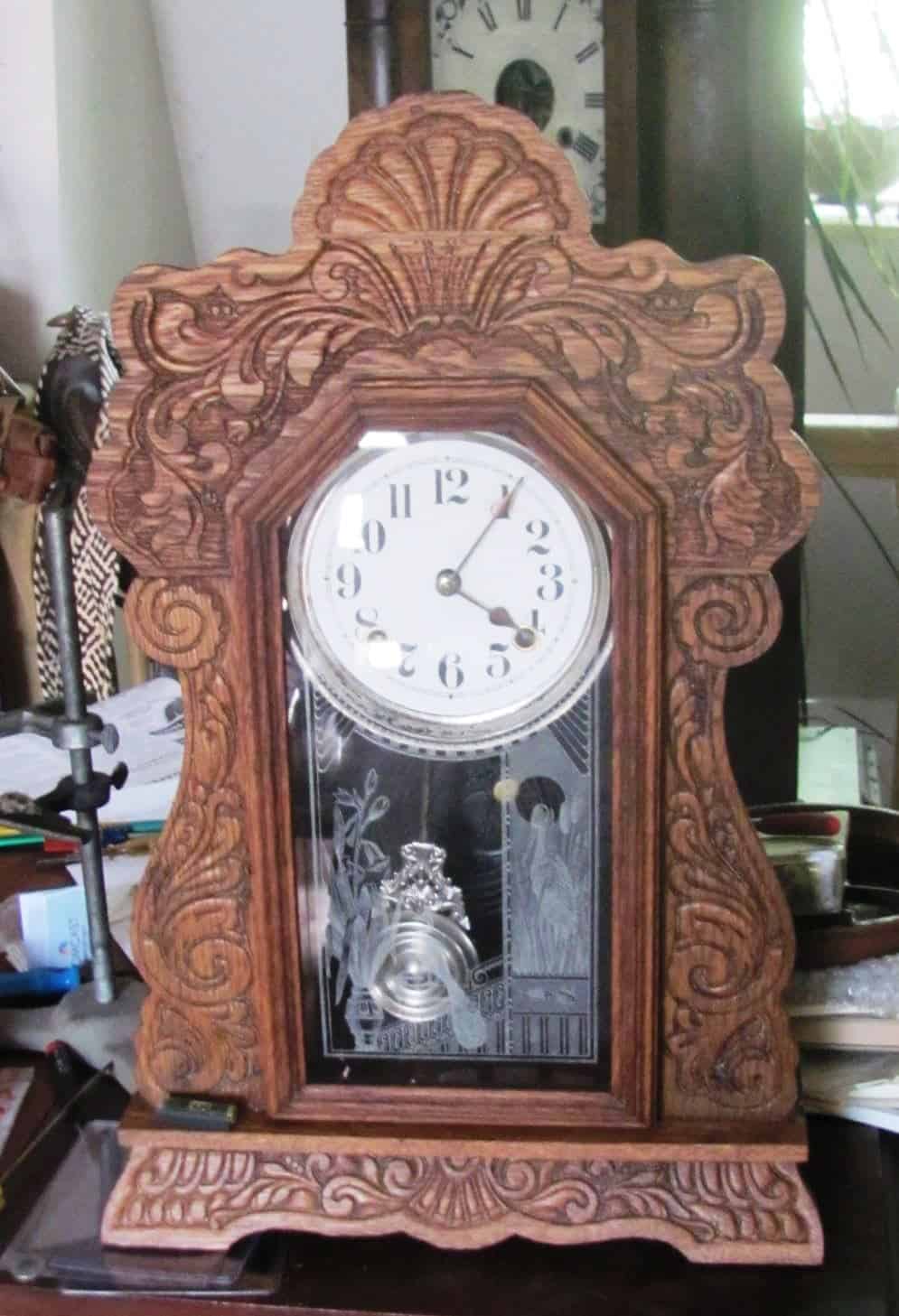
Steve Green asked if I would look at his wife’s family clock. Steve married Michelle Wade. The clock had been Michelle’s grandparent’s clock, Carroll and Edna Wade of Plymouth. It had resided in a closet for 30 years, awaiting resurrection.
This Ansonia clock was manufactured circa 1890 to 1900, and referred to as a “Kitchen clock,” at that time. Today in the trade, they are known as gingerbread clocks, and are often made of oak. Earlier examples were made of walnut.
Of interest to me, this clock is an oak case with a nickel-plated dial pan and nickel pendulum. The silver stencil on the tablet had been erased by years of aggressive cleaning. Usually, oak case gingerbreads have a brass dial pan, with gold stencil on the reverse side of the door tablet, and a brass pendulum.
Walnut case gingerbreads had a nickel-plated dial pan, silver stencil on the door tablet, and a nickel-plated pendulum. Why my interest, you might wonder. I think Ansonia made this oak case clock during their transition from walnut case to less expensive oak case clocks, using up their remaining supply of nickel-plated parts on a few oak gingerbreads. It is also possible it was a special order. Either way, it’s of interest to me.
Kerosene
Years ago, I met an old timer, who told me about using kerosene as an evaporative lubricant. He used a tin, screw top cover from a tin can. He placed the cover in the bottom of the clock case, containing kerosene, and closed the door. As the kerosene evaporated, it collected on the dial, movement, and pendulum. I don’t recommend this.
Over many years and refillings, the kerosene attracted the dust that gummed up the movement. The first thing I did was give the movement a good bath in clock cleaner. Then I dried and oiled the movement, greased the springs, and set it up in the test stand. It ran fine, with just minor tweaking needed.
Finish
When the clock was brought to me, it had been painted over twice, each time a different color. Using paint remover and hours of scrubbing and picking, I removed the paint as best I could. In the end grain the paint was very stubborn. In some places, I was able to hide the paint in the end grain with a colored pen. It was impossible to get it all.
The pendulum was heavily corroded from the kerosene. I went through my collection of clock parts and found the exact pendulum in mint condition. So I switched pendulums. I’m always looking for clock parts. Now you know why.
The Tablet
I called Lindy Larson down in Westminster to see if he had a gingerbread tablet with silver stencil. Lindy is a nationally known clock dealer. “Yes, come on down,” he said. Lee Decatur and I drove down to Lindy’s in Lee’s 1953 MG. It was an enjoyable ride in Precious.
Lindy had several tablets out for me to choose from. I selected a beautiful new old stock tablet. This tablet was not a stencil. The design you see is etched right into the glass. The tablet needed to be cut to size. Neither Lee nor I felt competent to cut the glass. One mistake and it’s over.
I took the doorframe and tablet to the Framery of Vermont to see if they would cut it. John DeBenedetti, using his wall mounted glasscutter, first cut the glass to size. Then he cut the angles at the top of the door. Perfect. I was holding my breath!
Refinish
After I was finished with paint remover, I went over the entire case with a fine steel wool. Now it was ready for a new finish. I used a golden oak stain. The wood was dry and thirsty, so it took three applications.
Restoring this clock required Lindy, John, and Lee’s help. The paper dial had yellowed from the kerosene and needed to be replaced. Lee cut a new dial and glued it to the dial pan.
This team effort resulted in a beautiful clock the family will enjoy for years to come. Like your car, antique clocks require periodic maintenance. I don’t do much clock repair anymore. I’ve always had a soft spot for Ansonia clocks and woodworks grandfather clocks.
This week’s old saying I heard years ago: “When you’re on a dirt road and come to a fork in the road, keep to the right if you don’t know which way to go. You’ll be right more times than wrong.”